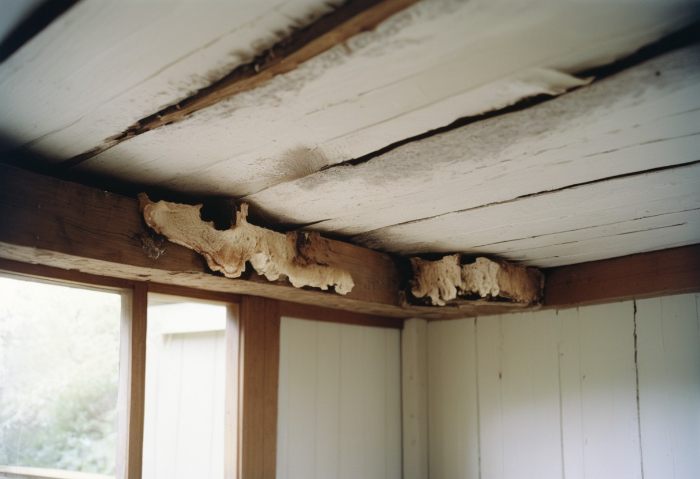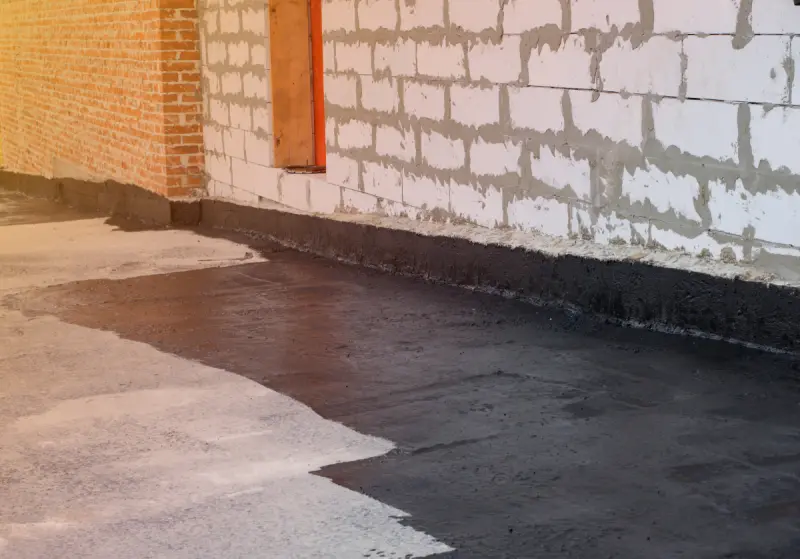Learn how to identify dry rot in your home with our comprehensive guide. Discover the signs, such as cracked or shrinking timber, a musty odour, and orange spore dust. Early detection of dry rot can prevent extensive damage, so explore what to look for and how to manage this serious issue effectively.
Wood Shrinks, Darkens and Cracks
One sign of dry rot in a house is the appearance of shrinkage, darkening, and cracking in timber. Affected timber may develop a brittle texture and change colour to a darker brown.
You may also notice a characteristic cracking pattern known as cuboidal cracking, where the wood breaks into cube-like pieces. This occurs as the fungus consumes the cellulose within the wood, causing it to weaken and crack. Checking for these signs on your floorboards, wall panels, or any wooden structure can help you identify dry rot early.
In addition to visible changes in the timber, you may detect a musty, damp smell in areas affected by dry rot. This odour is caused by the fungal growth process and can be a clear indicator of an underlying problem.
Another sign to look out for is the presence of fungal spores, which often appear as orange or reddish dust on the surface of the wood. These spores can spread through the air, colonising other damp areas in your home.
Dry rot can also cause structural damage. If you notice that wooden beams or supports appear to be sagging or feel soft when pressed, this could indicate an advanced stage of dry rot.
In severe cases, you may even observe fruiting bodies of the fungus, which look like fleshy, pancake-like growths on the surface of the wood. Regularly inspecting your home’s wooden elements for these warning signs can help you catch dry rot early, allowing for more effective treatment and repair.
Musty, Damp Odour
Dry rot often presents a distinctive musty, damp odour akin to the smell of mushrooms. This odour signifies the presence of moisture in the affected areas, which provides a conducive environment for the fungus to thrive. The fungus flourishes in damp conditions, and the scent indicates ongoing fungal decay.
If your home has a persistent and unusual smell, particularly near wooden structures, it is imperative to investigate further. Ignoring such odours can lead to a dry rot outbreak that may spread throughout the property, causing extensive damage. Moreover, the smell of dry rot is frequently associated with damp patches on walls or ceilings.
These patches indicate a nearby moisture source, ideal for fungal growth. If you detect such odours or observe damp patches, it is advisable to contact a professional for a thorough survey. Identifying dry rot at an early stage is crucial, as it helps in minimising the extent of damage and reducing the repair costs. Dry rot is a serious issue that requires prompt attention.
By recognising the signs early—such as the distinctive odour and damp patches—you can take preventative measures to protect your property from significant harm. Professional assessment and timely intervention are key to effectively managing and treating dry rot issues, ensuring the integrity and longevity of your home. If you suspect dry rot, do not delay in seeking expert advice to safeguard your property from further damage.

Mycelium Growth
Another clear sign of dry rot is the presence of mycelium growth. Mycelium appears as cotton wool-like masses, often grey or white in colour, and spreads across affected areas. This growth consists of a network of fungal threads called hyphae that feed on damp timber.
Mycelium is highly invasive and can infiltrate masonry and other materials, seeking more food sources and causing extensive damage. This ability to travel far from the initial moisture source makes it challenging to pinpoint the spread of the rot.
If you notice cotton wool-like patches on your wood or masonry, it is a clear indication of a dry rot problem. Immediate action is crucial, and you should contact a professional without delay. Early treatment can prevent mycelium from causing further structural damage, possibly saving you considerable repair costs and inconvenience.
Besides mycelium, look out for other signs of dry rot, such as deep cracks in the wood grain, a musty odour, and fruiting bodies that resemble mushrooms. These fruiting bodies are the reproductive structures of the fungus and release spores into the air, which can start new infestations in other damp areas of your property.
To sum up, early identification and swift intervention are vital when dealing with dry rot. Recognising the signs—especially the cotton wool-like mycelium—can help you take the necessary steps to protect your home’s structural integrity. Don't hesitate to seek professional help as soon as you suspect a dry rot issue to minimise potential damage and ensure the longevity of your property.
Fruiting Body
The presence of dry rot fruiting bodies is a telltale sign of a serious issue in your home. These fruiting bodies resemble fleshy pancakes or large, mushroom-like growths. They can vary in colour, typically ranging from orange to rusty red.
These fruiting bodies are not just unsightly; they play a significant role in the spread of dry rot. The fruiting bodies produce dry rot spores, which can travel and spread the fungus to other areas of your home. If you discover these mushroom-like growths, it is a clear indication that dry rot is present and actively spreading.
Detecting dry rot early is crucial because it can cause damage to the wooden structures in your home, weakening them and leading to potentially hazardous conditions. The spread of dry rot can compromise the integrity of your home's structure, making it unsafe and costly to repair.
Addressing the presence of fruiting bodies requires immediate attention to prevent further spread and damage. Ignoring this issue can result in more significant and expensive repairs down the line. If you do find dry rot fruiting bodies, it is advisable to seek professional assistance promptly.
Experts can assess the extent of the damage, identify the source of moisture contributing to the rot, and implement effective treatment methods to eradicate the fungus. Timely intervention is essential to ensure the stability and safety of your home's structure. Remember, tackling the issue at the earliest sign can save you from more complex and costly repairs in the future.

Affected Wood
Inspecting the condition of timber in your home is crucial for identifying dry rot. This type of fungal decay can be detrimental to the structural integrity of your house if left unchecked. Affected wood will often feel spongy to the touch, even if there are no visible signs of damage.
You might notice that the wood has a crumbly texture or that it has developed deep cracks. In more advanced stages of dry rot, timber may even break apart easily. The extent of the fungal growth can severely compromise the structural integrity of your home, leading to significant damage if left untreated.
Dry rot typically thrives in damp, poorly ventilated areas. Therefore, it is essential to regularly inspect parts of your home susceptible to moisture accumulation. These include basements, attics, cellars, and areas behind plaster or paint. Moist conditions create a breeding ground for the fungus responsible for dry rot, making these spots particularly vulnerable.
Pay close attention to any unusual changes in the texture or appearance of wooden structures. If you are trying to identify the early signs of dry rot, look for orange or brown spore dust. This is an indication of fungal activity. You might also encounter a distinctive musty odour emanating from affected areas.
Wooden surfaces may show signs of shrinkage and splitting. White or greyish fungal growth may also be observed, which can appear cotton wool-like in texture. Keep an eye out for deep cracks running across the grain of the wood, as this is another tell tale sign of dry rot infestation.
If you are unsure whether you have found dry rot, consulting a specialist who can provide a professional survey is recommended. They can offer a detailed assessment and suggest appropriate measures for treatment and prevention.
Ignoring the early signs of dry rot can lead to extensive and costly repairs. Prevention is often more manageable than cure, so regular inspections and maintaining good ventilation and dry conditions in your home are key strategies for keeping dry rot at bay.
Inspecting for dry rot involves looking out for changes. This can include wood texture, spore dust, and fungal growth. Regular checks in damp areas are crucial for early detection and prevention. Consulting a professional can ensure the correct identification and treatment of this potentially damaging issue.
At Above Water Damp Proofing Ltd we are trained professionals when it comes to dry rot and damp. We understand that damp removal and damp-proofing your property can be costly - which is why we provide a range of damp-proofing services at a fair price.
Learn more about our Dry Rot Specialist in Windsor, Slough, Berkshire & Surrey.




